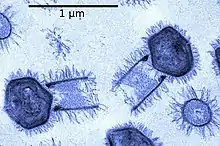Tupanvirus
Tupanvirus is the name of two giant viruses, Tupanvirus deep ocean and Tupanvirus soda lake. They are named after Tupã (Tupan), a Guaraní thunder god, and the places they were found. These are the first viruses reported to possess genes for amino-acyl tRNA synthetases for all 20 standard amino acids.[1][2][3]
| Tupanvirus | |
|---|---|
 | |
| Virus classification | |
| (unranked): | Virus |
| Realm: | Varidnaviria |
| Kingdom: | Bamfordvirae |
| Phylum: | Nucleocytoviricota |
| Class: | Megaviricetes |
| Order: | Imitervirales |
| Family: | Mimiviridae (?) |
| Genus: | Tupanvirus |
| Species | |
| |
Tupanvirus measure up to 1.2 μm in complete virion length, with a capsid similar to that of amoebal mimiviruses in size (~450 nm) and structure. However, the Tupanvirus virion presents a large cylindrical tail (~550 nm × 450 nm diameter) attached to the base of the capsid.[2] Some particles can reach up to 2.3 μm because of the variation in tail size.
Genome
The genome contains roughly 1.5 million base pairs of double-stranded DNA,[1] coding for 1276–1425 predicted proteins. Many genes that encode for processes found in cellular organisms are found in Tupanvirus genome.[2] As a giant virus, Tupanvirus present the largest translational apparatus within the known virosphere. The analysis of tupanviruses constitutes a new step towards understanding the evolution of giant viruses.
Host
Tupanviruses are able to infect protists and amoebas, but probably pose no threat to humans.[1]
References
- Garisto, Dan (27 February 2018). "These giant viruses have more protein-making gear than any known virus".
- Abrahão, Jônatas; Silva, Lorena; Silva, Ludmila Santos; Khalil, Jacques Yaacoub Bou; Rodrigues, Rodrigo; Arantes, Thalita; Assis, Felipe; Boratto, Paulo; Andrade, Miguel; Kroon, Erna Geessien; Ribeiro, Bergmann; Bergier, Ivan; Seligmann, Herve; Ghigo, Eric; Colson, Philippe; Levasseur, Anthony; Kroemer, Guido; Raoult, Didier; Scola, Bernard La (27 February 2018). "Tailed giant Tupanvirus possesses the most complete translational apparatus of the known virosphere". Nature Communications. 9 (1): 749. Bibcode:2018NatCo...9..749A. doi:10.1038/s41467-018-03168-1. PMC 5829246. PMID 29487281.
- Schulz, Frederik; Yutin, Natalya; Ivanova, Natalia N.; Ortega, Davi R.; Lee, Tae Kwon; Vierheilig, Julia; Daims, Holger; Horn, Matthias; Wagner, Michael; Jensen, Grant J.; Kyrpides, Nikos C.; Koonin, Eugene V.; Woyke, Tanja (7 April 2017). "Giant viruses with an expanded complement of translation system components" (PDF). Science. 356 (6333): 82–85. Bibcode:2017Sci...356...82S. doi:10.1126/science.aal4657. PMID 28386012.